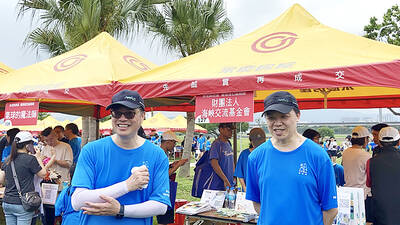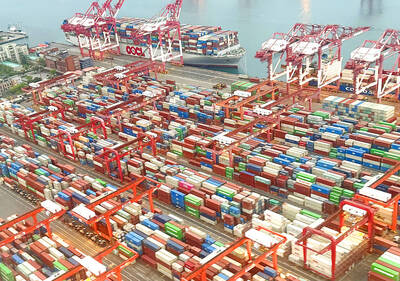The government is to pay at least NT$285.5 million (US$10.26 million) to national team athletes and their coaches after record-breaking performances at the Tokyo Olympic Games.
Taiwanese athletes have won 12 medals — two gold, four silver and six bronze — at the Games in the nation’s best-ever Olympic showing.
An Olympic gold-medal winner can receive a one-time prize of NT$20 million from the government, a silver awardee NT$7 million and a bronze winner NT$5 million, according to the Regulations Governing the Issuance of Guo Guang Athletic Medals and Scholarships (國光體育獎章及獎助學金頒發辦法).

Photo courtesy of EasyCard Corp
Weightlifter Kuo Hsing-chun (郭婞淳) and the badminton duo Lee Yang (李洋) and Wang Chi-lin (王齊麟) are to each receive NT$20 million for winning gold medals.
Medalists can also choose to receive the money in monthly payments, meaning a gold winner would receive NT$125,000 per month, a silver winner NT$38,000 and a bronze winner NT$24,000.
The Sports Administration also increases the prizes for medalists of certain disciplines, such as gymnastics, swimming, and track and field, who could receive 50 percent more.
For example, gymnast Lee Chih-kai (李智凱), dubbed the “prince of the pommel horse,” could receive NT$7 million plus NT$3.5 million for winning a silver.
Athletes who enter the round-of-eight in a competition are rewarded as well. An athlete placing fourth could receive a one-time prize of NT$3 million, while fifth and sixth place could receive NT$1.5 million. Those who enter a quarter-final without advancing to a semi-final would also receive NT$1.5 million.
Table tennis player Lin Yun-ju (林昀儒) could earn NT$9.5 million for his performance — NT$5 million for winning bronze in mixed doubles, NT$3 million for placing fourth in the men’s singles and NT$1.5 million for finishing fifth in the men’s team matches.
In addition, the Sports Administration last year amended the Regulations Governing Meritorious Coaches (有功教練獎勵辦法) to increase the rewards for coaches of award-winning athletes competing in the Asian Games or Olympic Games.
For example, Kuo’s weightlifting coach, Lin Geng-neng (林敬能), is eligible to receive a prize of NT$5 million, up from NT$3 million.
Premier Su Tseng-chang (蘇貞昌) said yesterday that Taiwanese are proud of national team athletes, as they often emphasize their origin as Taiwan after winning medals.
Su also commented on the resignation of Sports Administration Director-General Chang Shao-hsi (張少熙) over the flight seating arrangements for Taiwanese athletes.
On July 19, badminton star Tai Tzu-ying (戴資穎) posted a photograph of herself on Instagram, sitting in the economy class section of a China Airlines flight to Tokyo. Shortly after the post, it was discovered that some Taiwanese sports officials were seated in business class.
Su said that the government would review the issue after all athletes had returned from the Games.
Separately, EasyCard Corp yesterday announced a two-card set marking Tai’s silver medal win at the Games.
The set features Tai’s signature and her motto, “Believe in Yourself,” which came from her father and is tattooed on her left wrist, it said.
Sold at NT$350, the cards are available for pre-order from 11am today until 11:59pm on Thursday at 7-Eleven, FamilyMart, Hi-Life and OK Mart convenience stores, it said.
EasyCard has worked with Tai previously for card promotions.
Additional reporting by Lu Hsiu-hsien and Tsai Ya-hua

SECURITY: As China is ‘reshaping’ Hong Kong’s population, Taiwan must raise the eligibility threshold for applications from Hong Kongers, Chiu Chui-cheng said When Hong Kong and Macau citizens apply for residency in Taiwan, it would be under a new category that includes a “national security observation period,” Mainland Affairs Council (MAC) Minister Chiu Chui-cheng (邱垂正) said yesterday. President William Lai (賴清德) on March 13 announced 17 strategies to counter China’s aggression toward Taiwan, including incorporating national security considerations into the review process for residency applications from Hong Kong and Macau citizens. The situation in Hong Kong is constantly changing, Chiu said to media yesterday on the sidelines of the Taipei Technology Run hosted by the Taipei Neihu Technology Park Development Association. With

CARROT AND STICK: While unrelenting in its military threats, China attracted nearly 40,000 Taiwanese to over 400 business events last year Nearly 40,000 Taiwanese last year joined industry events in China, such as conferences and trade fairs, supported by the Chinese government, a study showed yesterday, as Beijing ramps up a charm offensive toward Taipei alongside military pressure. China has long taken a carrot-and-stick approach to Taiwan, threatening it with the prospect of military action while reaching out to those it believes are amenable to Beijing’s point of view. Taiwanese security officials are wary of what they see as Beijing’s influence campaigns to sway public opinion after Taipei and Beijing gradually resumed travel links halted by the COVID-19 pandemic, but the scale of

Pope Francis is be laid to rest on Saturday after lying in state for three days in St Peter’s Basilica, where the faithful are expected to flock to pay their respects to history’s first Latin American pontiff. The cardinals met yesterday in the Vatican’s synod hall to chart the next steps before a conclave begins to choose Francis’ successor, as condolences poured in from around the world. According to current norms, the conclave must begin between May 5 and 10. The cardinals set the funeral for Saturday at 10am in St Peter’s Square, to be celebrated by the dean of the College

TRADE: A mandatory declaration of origin for manufactured goods bound for the US is to take effect on May 7 to block China from exploiting Taiwan’s trade channels All products manufactured in Taiwan and exported to the US must include a signed declaration of origin starting on May 7, the Bureau of Foreign Trade announced yesterday. US President Donald Trump on April 2 imposed a 32 percent tariff on imports from Taiwan, but one week later announced a 90-day pause on its implementation. However, a universal 10 percent tariff was immediately applied to most imports from around the world. On April 12, the Trump administration further exempted computers, smartphones and semiconductors from the new tariffs. In response, President William Lai’s (賴清德) administration has introduced a series of countermeasures to support affected